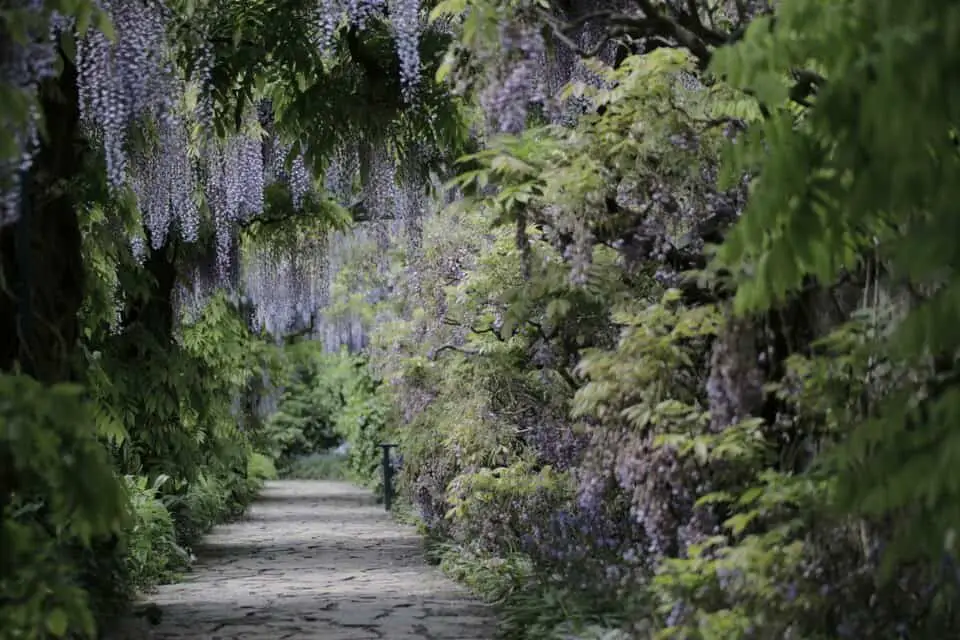Some links in the post are affiliate links and I get a commission from purchases made through some links found in the post.
Wisteria is a free climbing shrub of the legume family. It has dangle and float clusters of fragrant flowers in purple, blue, white, violet red, and pink.
There are mainly three varieties of wisteria popular among gardeners: Japanese, Chinese, and North American. It is mainly grown on the walls and pergolas for an ornamental touch.
The conflict between wisteria tree and a vine is troublesome one to resolve. According to a botanist, there isn’t any biological between the wisteria tree and the wisteria vine.
The wisteria tree stands firmly without any support and holds its weight. On the contrary, wisteria vine grows on walls and pergolas thriving on any support.
The key point in the story of wisteria trees vs wisteria vines is that both categories are almost the same, it just depends on how you train your wisteria.
Wisteria woody vines are very sturdy, and it is very hard to remove them. When you start growing it, it might need a support to rely on, but after it is mature, it becomes resilient to hold itself.
Let’s dig deep into the wisteria tree vs vine guide to become clearer in this conflict.
What is the Difference Between a Wisteria Tree and Wisteria Vine?
 In the dispute of a wisteria tree vs a wisteria vine, you can judge the difference based on their growth style, time, and variety.
In the dispute of a wisteria tree vs a wisteria vine, you can judge the difference based on their growth style, time, and variety.
If we compare the varieties, then the American Wisteria has some different results as compared to the Asian Varieties.
The American varieties of wisteria include Amethyst Falls, and Blue Moon also known as Kentucky Wisteria. Both types are less aggressive and easy to train as a trunk.
If you’re plant to create standard wisteria trees, then go for them. They have easy vines to be twisted and will form a nice wisteria tree, but it will take more time compared to the Asian varieties.
On the contrary, Japanese and Chinese varieties of wisteria usually make good wisteria vine and are best for the outside wall décor and pergola’s shade.
But there are some Japanese varieties that can form a nice tree, such as Lavender falls and Domino.
But Chinese varieties of the wisteria are only known for the wisteria vine. In case you consider this variety of training into a tree, it might take more time and results might be difficult to take out.
The major difference between the wisteria in Japanese and Chinese is the different directions of the vine twisting.
If your wisteria vines are twisting around its support in a clockwise direction, then you are growing a Japanese variety. On the contrary, if they are twisting in an anticlockwise direction then they are American or Chinese.
The American Variety has soft vines and takes more time to grow as compared to the Chinese variety.
You may also like: The common problems with a wisteria & how to fix them
How do you Train a Wisteria into a Tree?
It is very easy to train wisteria into a tree. You arrange the vines by twisting them and creating a trunk-like format, it becomes standard wisteria. The main trunk will go up, but it will be spreading and forming a water-fall-like structure.
The term “standard” is used in plant physiology to describe the fact that a vine or shrub is the primary characteristic of the plant but with the help of pruning and training, it has converted into a tree-like structure.
Now, let’s train wisteria into a tree step by step. Before we start with the guide, you just need to make up your mind that it is not going to be easy. It requires hard work, strength, and time. But the result will be worth it.
1) Support
First of all, you need to add support to your wisteria. If you’re digging a hole for new wisteria then dig a hole up to 14 to 18 inches down for support.
You can choose a wooden post or a steel fence post to give support to wisteria. While the length of the post depends on the length of the wisteria tree you desire.
2) Space
Leave two to three inches of space between the wisteria vine and post. This space helps the wisteria to grow. Now, you have to choose the main vine of the wisteria to form a trunk.
It is favorable to go with the thick and strong vine as compared to the other one. If you have the two main vines then twist them together to form a trunk.
After that, you must tie the post with the vine with soft ties do not use wire for this purpose. Tie it strongly so that it will not fall on the ground.
But you must loosen the tie a little bit weekly or biweekly when you observe the plant is growing and needs more space.
Now, some prefer only one tie, but wisteria vines usually grow in a different direction which requires more ties to grow.
Tie down your post with the twisted vine for every eight to ten inches. And repeat the process until the twisted vines form a mature trunk.
3) Pruning
The last step is to cut down all the extra parts from the vines with the help of Pruners. Keep in mind that you only need to use pruners on the main or twisted vine.
If you cut all the stems, then the plant will not have any leaves. Only cut the extra stems or leaves from the vine which you wanted to be a trunk in the future and let the others grow.
You have to repeat the process twice a month for the proper shape. It will take a year to two to form the required shape.
4) Future care
For the future wisteria tree care, you need to prune the old branches and also get rid of the unnecessary stems or vines. But let the upper vine grow.
After two to three years, it becomes strong enough to hold its strength and it will need more water. Don’t let the soil dry out completely between the watering.
Add fertilizer that has a low amount of nitrogen. The regular fertilizer might cause fertilizer burn in the plant. Wisteria takes a good five years to fully form a tree and, in some areas, it takes more time.
You may also like: 6 great benefits of owning a wisteria
Final Thoughts: Wisteria Tree vs Vine
 Training a wisteria into a tree might be a hard job but you will be amazed by the result of this technique.
Training a wisteria into a tree might be a hard job but you will be amazed by the result of this technique.
It is difficult to get the desired result but in order to receive the tree-like structure, you have to provide the support to the wisteria until it gets mature and attains a particular shape.
One thing you need to keep in mind is the vining nature of the plant. It is favorable not to plant the wisteria near any other tree.
Because wisteria vines might try to get hold of the stems of the other tree. That’s how it will have become more demanding for you to turn it into a tree.
Moreover, if you’re planning to train the wisteria into a tree, you can also consider the option of settling it into a pot or container.
The wisteria tree adds extra flavor to your garden. Even if you are training your wisteria into a tree in a small pot or a container, then it can be used as an inside décor part.
Before you go, here are some more related articles I encourage you to read below to help solve more of your gardening issues:
How Long Does Wisteria Bloom For


